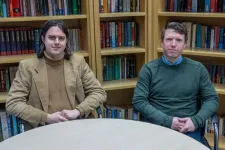(Press-News.org) INDIANAPOLIS — It’s no secret that a good night’s rest can do wonders for one’s health, but those who struggle with insomnia have a nearly 50% increased risk of cardiovascular disease. One scientist in the School of Science at IUPUI will spend the next five years trying to figure out how those risks can be reduced.
Jesse Stewart, a professor of psychology at the school, has received a five-year, $3 million grant from the National Institutes of Health’s National Heart, Lung and Blood Institute for a project named the Strengthening Hearts by Addressing Disrupted Sleep, or SHADES, Mechanistic Trial.
The aim of the SHADES trial is to discover whether the treatment of insomnia can reduce the risk for cardiovascular disease.
“There’s a growing body of research linking various issues with sleep and future risk for developing cardiovascular disease,” Stewart said. “What’s not known is whether that connection is causal. By that, I mean if we treat the insomnia, if we treat the sleep problems, if we improve sleep, does that lower cardiovascular disease risk similar to treating high blood pressure or high cholesterol? That’s what we’re hoping to find out.”
The SHADES trial will recruit 200 patients with insomnia from eight primary-care clinics at Eskenazi Health. Patients will be randomly assigned to two groups and be treated for six months. Half of the trial participants will receive “modernized collaborative care” for insomnia; the other half will receive standard primary care for insomnia, with some added benefits.
The modernized collaborative care features what Stewart calls the “gold standard” treatment for insomnia: cognitive behavioral therapy, or CBT-I. Patients under this treatment plan will receive CBT-I online, via telephone or in person. The other group will receive education about sleep and “sleep hygiene,” have their insomnia symptoms monitored and visit their primary-care providers.
To determine the impact of insomnia treatment on cardiovascular disease risk, Stewart and his collaborators will obtain blood-based measures of systemic inflammation, such as C-reactive protein, as well as measurements of metabolic dysregulation, such as blood sugar levels. They will also obtain physiological measures of autonomic nervous system dysfunction in both the sympathetic and parasympathetic branches.
“We expect our CBT-I treatment to beat the control, which will allow us to dive into whether or not improving insomnia trickles down to biological mechanisms involved in the development of cardiovascular disease,” Stewart said. “By following people for six months, we hope to see markers of cardiovascular risk improve. Those same markers have been shown in other studies to predict future heart attacks and strokes.”
A modernized collaborative care approach was also the focus of Stewart’s research on relationship between depression and cardiovascular disease published this year in the journal Brain, Behavior and Immunity. Because of differences in treatment for depression and insomnia, as well as encountered barriers to treatment, Stewart decided to modify the treatment approach in the SHADES trial.
For instance, basic computer training and tablets — with unlimited data plans for those without a computer with internet access — are now available to patients in the trial.
“We’re making treatment more accessible than in the past, building off our prior work and bridging the digital divide,” Stewart said. “The idea is to make these treatments more accessible and convenient by using technology. Then, if we need to or prefer it, they can come in and meet face-to-face with a therapist.”
Overall, through the SHADES trial and other research projects, Stewart strives to advance understanding of the links between psychological factors, their treatment and cardiovascular disease risk in the hopes of developing new approaches to prevent cardiovascular disease.
“There are a lot of missed opportunities to prevent disease and improve the health of people in the world, and I hope to shed some light on that,” he said. “The long-term goal is to broaden the view of cardiovascular disease risk factors and to motivate screening and treatment programs, like for insomnia, to address these currently unaddressed, potentially causal cardiovascular risk factors.”
Researchers on the SHADES trial team include Wei Wu from the School of Science at IUPUI; Yelena Chernyak, Robert Considine, Babar Kahn and Subha Raman of the Indiana University School of Medicine; Julie Otte of the IU School of Nursing; Krysha MacDonald from Eskenazi Health; Lee Ritterband and Karen Ingersoll from the University of Virginia; and Michael Irwin from University of California at Los Angeles. Research partners include the Indiana Clinical and Translational Sciences Institute, Regenstrief Institute, University of Virginia and UCLA.
END
Can insomnia treatment reduce cardiovascular disease risks? $3 million funds study to find out
2023-10-25
ELSE PRESS RELEASES FROM THIS DATE:
Higher levels of triglycerides linked to lower risk of dementia
2023-10-25
EMBARGOED FOR RELEASE UNTIL 4 P.M. ET, WEDNESDAY, OCTOBER 25, 2023
MINNEAPOLIS – Older people who have higher levels of triglycerides, a type of fat, may have a lower risk of dementia and a slower cognitive decline over time compared to people who have lower levels, according to new research published in the October 25, 2023, online issue of Neurology®, the medical journal of the American Academy of Neurology. While the study found a link, it does not prove that higher levels of triglycerides prevent dementia.
Triglycerides are fatty acids and are the most common type of fat in the blood. Triglycerides contribute ...
Childhood trauma linked to headaches in adulthood
2023-10-25
EMBARGOED FOR RELEASE UNTIL 4 P.M. ET, WEDNESDAY, OCTOBER 25, 2023
MINNEAPOLIS – People who have experienced traumatic events in childhood such as abuse, neglect or household dysfunction may be more likely to experience headache disorders as adults, according to a meta-analysis published in the October 25, 2023, online issue of Neurology®, the medical journal of the American Academy of Neurology. This research does not prove that such experiences cause headaches; it only shows an association.
“Traumatic events in childhood can have ...
Brittle star fossils found in South Africa are over 410 million years old, the oldest known examples who lived at high latitude
2023-10-25
Brittle star fossils found in South Africa are over 410 million years old, the oldest known examples who lived at high latitude
###
Article URL: https://journals.plos.org/plosone/article?id=10.1371/journal.pone.0292636
Article Title: Earliest known ophiuroids from high palaeolatitude, southern Gondwana, recovered from the Pragian to earliest Emsian Baviaanskloof Formation (Table Mountain Group, Cape Supergroup) South Africa
Author Countries: South Africa, Luxembourg
Funding: RWG: Millennium Trust, South Africa (no number). https://www.mtrust.co.za ...
New distractibility “d factor” may be linked with ADHD
2023-10-25
In a study of different types of distraction involving more than 1,000 participants, researchers statistically derived a novel measure—dubbed the “d factor”—that could represent a person’s general tendency towards distraction and may be linked with attention-deficit/hyperactivity disorder (ADHD). Han Zhang of the University of Michigan, Ann Arbor, and colleagues present these findings in the open-access journal PLOS ONE on October 25, 2023.
Prior research has explored various types of distraction, such as external stimulations, repetitive ...
Deepfake videos during Russian invasion of Ukraine could undermine trust
2023-10-25
A new study explores themes in Twitter discussions of deepfake videos related to the Russian invasion of Ukraine, highlighting the potential for real videos to be mistaken for deepfakes and for deepfakes to fuel conspiracy theories. John Twomey of University College Cork, Ireland, and colleagues present these findings in the open-access journal PLOS ONE on October 25, 2023.
Created using artificial intelligence, deepfake videos typically feature a person saying and doing things they never actually did in real life. Deepfake technology has advanced considerably, sparking concerns about its potential harms. ...
In Prehispanic Cancun, immigrants were treated just like Maya locals
2023-10-25
Ancient people immigrated to Cancun Island and were treated just like locals, according to a study published October 25, 2023 in the open-access journal PLOS ONE by Andrea Cucina of the Autonomous University of Yucatan, Mexico and colleagues.
The Late Postclassic (AD 1200-1500) in the northern Maya lowlands was a period of major changes, including the development of many settlements along the east coast of the Yucatan Peninsula, influenced in part by expanded trade routes. Previous research has found that these settlements were home to many non-local individuals, but it remains unclear whether these people were treated as “foreigners” ...
Climate change likely impacted human populations in the Neolithic and Bronze Age
2023-10-25
Human populations in Neolithic Europe fluctuated with changing climates, according to a study published October 25, 2023 in the open-access journal PLOS ONE by Ralph Großmann of Kiel University, Germany and colleagues.
The archaeological record is a valuable resource for exploring the relationship between humans and the environment, particularly how each is affected by the other. In this study, researchers examined Central European regions rich in archaeological remains and geologic sources of climate data, using these resources to identify correlations between human population trends and climate change.
The ...
First ever study of wartime deepfakes reveals their impact on news media
2023-10-25
A first ever study of wartime deepfake videos reveals their impact on news media and outlines implications for social media companies, media organisations and governments.
Deepfakes are artificially manipulated audio-visual material. Most deepfake videos involve the production of a fake ‘face’ constructed by Artificial Intelligence, that is merged with an authentic video, in order to create a video of an event that never really took place. Although fake, they can look convincing and are often produced to imitate or mimic an individual.
Researchers at University ...
Anti-anxiety drug may improve brain cancer survival chances
2023-10-25
A new research study shows that cerebrospinal fluid reduces current treatment efficacy in brain cancer and identifies new therapeutic opportunities.
Cerebrospinal fluid, the clear colourless liquid that protects the brain, also may be a factor that makes brain cancers resistant to treatment, Australian researchers led by Associate Professor Cedric Bardy at the South Austraila Health and Medical Research Institute (SAHMRI) and Flinders University reveal in the journal Science Advances.
Reporting how this occurs, the study in high-profile journal Science Advances shows that a decades-old anti-anxiety drug can improve the effectiveness of chemo-radiotherapy ...
Something in the eyes: Java Sparrows in love show enhanced eye rings
2023-10-25
Pair-bonded Java sparrows show enlarged eye rings to signal breeding readiness.
Birds are known for their elaborate courtship rituals and romantic gestures that are replete with beautiful songs, complex dances, gift-giving practices, preening, and flamboyant plumage. While changes in colorful external attributes during this period has attracted much attention, the role of facial features remains an under-investigated aspect of this behavior.
Associate Professor Masayo Soma and her research group at the Graduate School of Science, Hokkaido University, reported increased swelling in Java sparrows’ eye rings—an area of blushed bare skin around the eyes—upon ...










